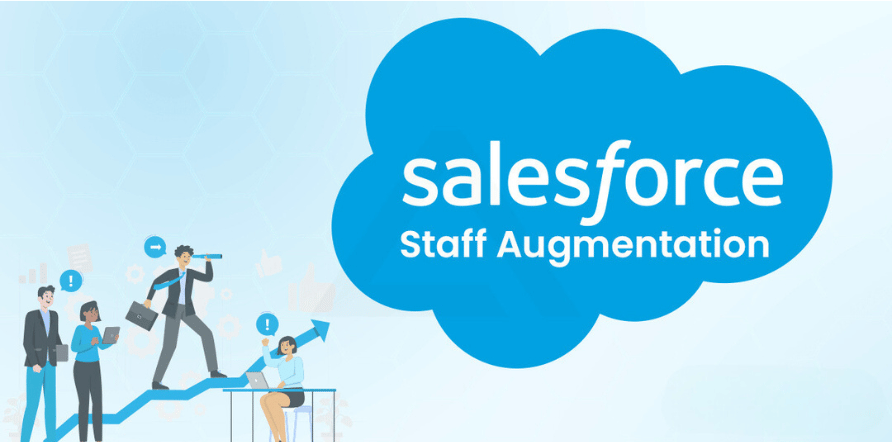
Staff Augmentation is a solution designed to help companies quickly and cost-effectively build or upskill their Salesforce teams while maintaining high technical quality. By hiring skilled contractors for 40 hours a week, businesses can accomplish critical tasks without the lengthy hiring process, onboarding delays, or higher costs associated with full-time employees.
This model allows you to scale your Salesforce team efficiently, avoiding the complexities and administrative overhead of traditional hiring processes.
While still relatively unfamiliar to many executives and hiring managers, Staff Augmentation is gaining popularity. It enables businesses to create an agile, flexible, and budget-friendly Salesforce team based on their specific needs.
Staff Augmentation often involves hiring offshore talent, typically facilitated through a reliable partner with expertise in this area and the knowledge of the local market. With this model, you can have a fully operational “in-house” team within days, significantly reducing costs and timelines compared to traditional hiring methods.
Staff Augmentation, once popular with large enterprises, is now gaining traction among mid-sized businesses and startups due to the rise of remote work. It’s ideal for companies that want to handle Salesforce strategy in-house but need external expertise for execution and maintenance.
Common roles sourced through Staff Augmentation include Salesforce Engineers, Developers, Admins, Technical Architects, and Solution Architects. This model works well for tasks like managing day-to-day Salesforce operations, where minimal strategy is needed.
Unlike Managed Services, which are suited for businesses looking to outsource everything, Staff Augmentation is for those who know what they need done and just need the right talent to execute it.


Salesforce staff augmentation provides businesses the opportunity to customize their engagements to fit client and stakeholder needs.
Budget flexibility
Hiring a full-time employee isn’t always in the cards when it comes to staying within budget boundaries. Full-time employees require the added cost of benefits like insurance, PTO, training, and more. Many companies circumnavigate those requirements by hiring contractors from staffing firms that cover those administrative needs, thereby increasing headcount without officially hitting defined resource restraints.
Continuity
Team managers or Salesforce admins can focus on the work at hand as they oversee the project responsibilities and collaboration of an extended team, without the hassle of coordinating administrative duties and employment agreements as their team size ebbs and flows to meet project needs.
Autonomy
You get to choose the candidates that best meet your needs, criteria, and timeframe. And you still manage the contractors with the methods your business prefers. There is no need to differentiate management styles between contractors and full-time employees. When the skills of one contractor are no longer needed, you can source a new contract with the next skills required for project completion.
But what about the long-term?
Staff augmentation is no longer just a solution to budget constraints or short-term needs. With the rise of cloud technology, remote work, and widespread acceptance of flexible work locations, businesses now have the flexibility to extend contracts for longer durations at a lower cost. As business systems evolve and are maintained over time, the knowledge about these systems and associated processes is often managed by augmented staff. Transitioning this knowledge to a full-time employee can require additional investment.
Furthermore, businesses face the challenge of managing attrition among these specialized staff members. These issues often result in companies relying on long-term contractors at high costs. The real challenge then becomes: How can a business maintain and enhance its existing systems, while also expanding its capabilities and integrating new technologies, all within an acceptable budget?
Staff Augmentation can seem daunting for many organizations, especially when it comes to integrating offshore talent. The two main concerns are time zone differences and hiring in unfamiliar markets. Here’s how to address them:
Hiring in Unfamiliar Markets
Recruiting offshore can be risky and time-consuming, especially without local knowledge. To mitigate this, partner with an agency that understands the local labor market and has established networks. Agencies like FoundHQ, with strong local connections and referral networks, can help ensure you hire the right talent with minimal risk.


Staff augmentation, when conducted by a project management company, follows a systematic process to ensure businesses gain the right expertise, seamlessly integrate new talent, and achieve project goals efficiently. Here’s a breakdown of how a project management company typically handles staff augmentation:
In summary, a project management company ensures the entire staff augmentation process is aligned with the client’s goals, from identifying needs and recruiting the right talent to integrating new resources into the team and providing continuous support. This approach allows businesses to scale their workforce flexibly, without long-term commitments, and optimize project delivery.
Both models offer flexibility and cost-effectiveness but differ in scope. Team augmentation is more about expanding team dynamics, while resource augmentation focuses on fulfilling specific roles or needs.


Staff Augmentation is a solution designed to help companies quickly and cost-effectively build or upskill their Salesforce teams while maintaining high technical quality. By hiring skilled contractors for 40 hours a week, businesses can accomplish critical tasks without the long hiring process, onboarding delays, or higher costs associated with full-time employees.
This model allows you to scale your Salesforce team efficiently, avoiding the complexities and administrative overhead of traditional hiring processes.
While still relatively unfamiliar to many executives and hiring managers, Staff Augmentation is gaining popularity. It enables businesses to create an agile, flexible, and budget-friendly Salesforce team based on their specific needs.
Staff Augmentation often involves hiring offshore talent, typically facilitated through a reliable partner with expertise in this area and knowledge of the local market. With this model, you can have a fully operational “in-house” team within days, significantly reducing costs and timelines compared to traditional hiring methods.

Staff Augmentation, once popular with large enterprises, is now gaining traction among mid-sized businesses and startups due to the rise of remote work. It’s ideal for companies that want to handle Salesforce strategy in-house but need external expertise for execution and maintenance.
Common roles sourced through Staff Augmentation include Salesforce Engineers, Developers, Admins, Technical Architects, and Solution Architects. This model works well for tasks like managing day-to-day Salesforce operations, where minimal strategy is needed.
Unlike Managed Services, which are suited for businesses looking to outsource everything, Staff Augmentation is for those who know what they need done and just need the right talent to execute it.

Salesforce staff augmentation provides businesses the opportunity to customize their engagements to fit client and stakeholder needs.
Budget flexibility
Hiring a full-time employee isn’t always in the cards when it comes to staying within budget boundaries. Full-time employees require the added cost of benefits like insurance, PTO, training, and more. Many companies circumnavigate those requirements by hiring contractors from staffing firms that cover those administrative needs, thereby increasing headcount without officially hitting defined resource restraints.
Continuity
Team managers or Salesforce admins can focus on the work at hand as they oversee the project responsibilities and collaboration of an extended team, without the hassle of coordinating administrative duties and employment agreements as their team size ebbs and flows to meet project needs.
Autonomy
You get to choose the candidates that best meet your needs, criteria, and timeframe. And you still manage the contractors with the methods your business prefers. There is no need to differentiate management styles between contractors and full-time employees. When the skills of one contractor are no longer needed, you can source a new contractor with the next skills required for project completion.
But what about the long-term?
Staff augmentation is no longer just a solution for budget constraints or short-term needs. With the rise of cloud technology, remote work, and widespread acceptance of flexible work locations, businesses now have the flexibility to extend contracts for longer durations at a lower cost. As business systems evolve and are maintained over time, the knowledge about these systems and associated processes is often managed by augmented staff. Transitioning this knowledge to a full-time employee can require additional investment.
Furthermore, businesses face the challenge of managing attrition among these specialized staff members. These issues often result in companies relying on long-term contractors at high costs. The real challenge then becomes: How can a business maintain and enhance its existing systems, while also expanding its capabilities and integrating new technologies, all within an acceptable budget?

Staff Augmentation can seem daunting for many organizations, especially when it comes to integrating offshore talent. The two main concerns are time zone differences and hiring in unfamiliar markets. Here’s how to address them:

Both models offer flexibility and cost-effectiveness but differ in scope. Team augmentation is more about expanding team dynamics, while resource augmentation focuses on fulfilling specific roles or needs.

Staff augmentation, when conducted by a project management company, follows a systematic process to ensure businesses gain the right expertise, seamlessly integrate new talent, and achieve project goals efficiently. Here’s a breakdown of how a project management company typically handles staff augmentation:
In summary, a project management company ensures the entire staff augmentation process is aligned with the client’s goals, from identifying needs and recruiting the right talent to integrating new resources into the team and providing continuous support. This approach allows businesses to scale their workforce flexibly, without long-term commitments, and optimize project delivery.
Copyright © 2025 Briskminds | All Rights Reserved